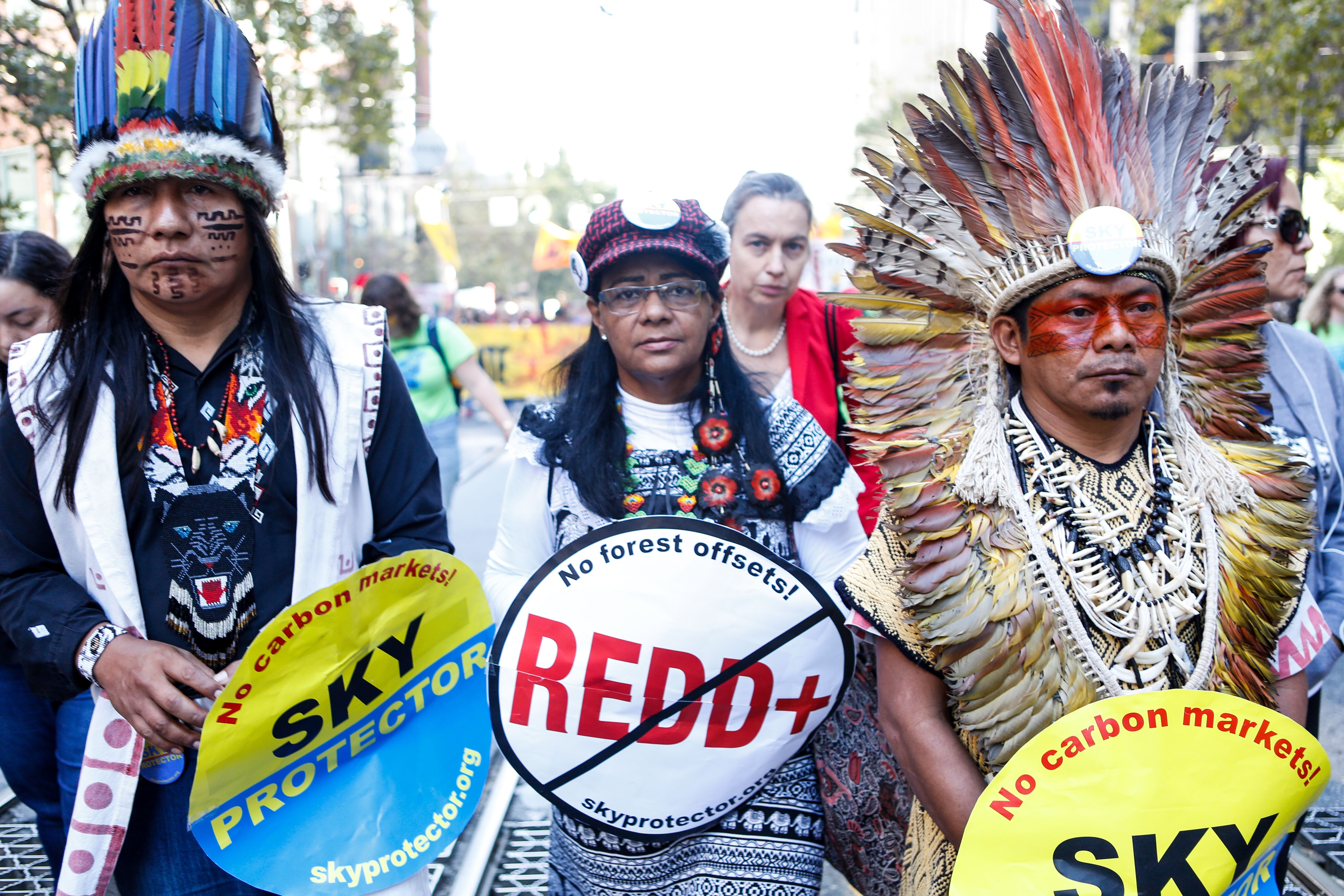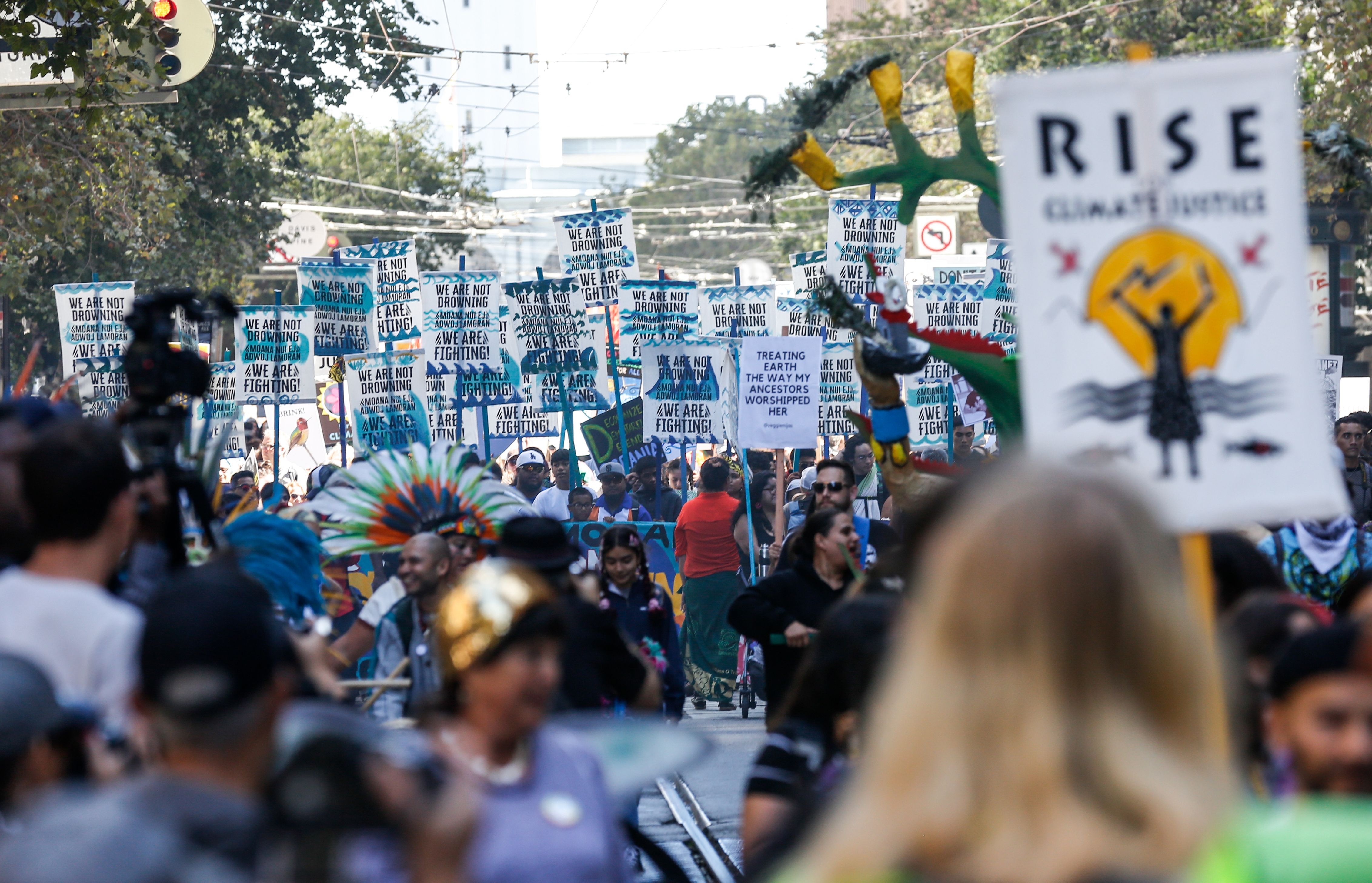
(Photo: Amy Osborne/ AFP/Getty Images)
There were effigies and prayer beads, pagans and Catholics. There were Amazonian tribal chiefs and American veterans and at least three people dressed in bright-orange tyrannosaurus costumes. There were small children making peace signs and senior citizens holding placards that said “WOKE GRANDMA.” The Brass Liberation Orchestra picked up their horns and blew woozy blues, and the Jewish Folk Chorus of San Francisco sang songs by the Everly Brothers. By the time the crowds reached San Francisco City Hall on Saturday, the “Rise for Climate” demonstration had an estimated 30,000 people marching, and 350.org called it the largest climate rally on the West Coast, ever.
The march—and the others like it that happened on Saturday around the country and the world—comes just at the start of this week’s Global Climate Action Summit; many marchers also said they wanted to send an uncompromising message to United Nations climate honchos ahead of the 24th annual Conference of the Parties (COP24) in Katowice, Poland, this December. San Francisco was not the only major action: In Paris, more than 18,000 marched, per police estimates—though rosier projections put that number closer to 50,000.
Many marchers directed their messages at California Governor Jerry Brown, who appeared in unflattering caricatures on various signs and floats throughout the crowd. Brown has emerged as something of a national climate hero for his vocal and colorful opposition to the regressive climate policies of the Trump administration, but he also faces plenty of criticism from the left: While Brown has signed legislation to prevent the Trump administration from expanding offshore drilling, many activists and climate scientists argue that he is still helping to extend the lifespan of oil and fracking in California.
Pacific Standard attended the march and spoke with a variety of activists about their reasons for marching and what, if anything, gives them hope.

Jeanne and Nessie
Jeanne and Nessie attended the march with The 1,000 Grandmothers coalition. They’re new to that group, they tell me, but they’ve both been involved in other forms of activism for years, on climate and labor, among other matters.
“We’re here because we’re very worried about the future of our planet and about our kids and about our grandkids—and even ourselves, at the rate at which this administration is allowing our country and our world to crumble,” Jeanne says. “We’re out here as grandmas. We’re non-threatening, peaceful people, but we want to be heard and we want to be seen.”
“I think that older women have a wisdom and a maturity and a sort of gravitas,” Nessie says. “There’s something powerful about older women and older men being part of this movement.”
“I don’t think it’s really as common unfortunately, in our current culture, to look to older women,” Jeanne says, “but hopefully we can change that because we’ve got the right idea.”
“We want to work on all these issues together,” Nessie says, “so I am excited that labor is here, because we’re really focusing on good jobs and climate change together. It’s not one against the other; we’re all in this fight together. And the labor contingent”—she gestures to the local group from Service Employees International Union—”is right behind us.”

(Photo: Amy Osborne/AFP/Getty Images)
Chief Ninawá Inú Hunikui
Chief Ninawá Inú Hunikui is president of the indigenous Federation of the Huni Kui People in the Brazilian state of Acre. He attended “Rise for Climate” to protest REDD+, the United Nations program that leverages carbon trading (largely among first-world companies) to minimize deforestation in the developing world. Critics say that REDD+ is a license to continue deforestation, often while trampling indigenous rights.
“Our message is to those people who don’t understand that you can’t protect the rainforest with money and with carbon-trading,” Ninawá says. “I’m here today to defend the Brazilian Amazon from REDD+ [carbon forest offsets], because it’s a false solution to climate change. I want to say to the United States government that they’d better respect the peoples of the world, that they’d better open their heart and find some love for their brother and sister human beings, because our job here on the planet is to defend Mother Earth. If they just destroy everything with their greed, they won’t be able to eat their money.”

(Photo: Amy Osborne/AFP/Getty Images)
Mirian Cisneros, President of the Pueblo of Sarayaku, Ecuador
Ecuadorian indigenous leader Mirian Cisneros attended the march to represent the Sarayaku, an indigenous people of the Ecuadorian Amazon. Cisneros is also attending the GCAS, where she plans to submit a proposal for rainforest sustainability—”Selva Viviente,” or “Living Forest,” which advocates a permanent legal recognition of indigenous territorial rights. I ask Cisneros whether she thinks Americans can really understand what’s at risk for first peoples in the Amazon.
“People here live in a place very different from Ecuador,” she says. “I think people here are not relating to Mother Earth. In the forest, we live in harmony with everything around us, with rivers, with mountains, with lakes, and we believe that everything is living.”
That awareness, Cisneros explains, inculcates a respect for the planet and its interconnectedness. “The planet depends on us; the Earth, the rivers, the mountains, the trees provide us with oxygen, and we need to ensure that we protect them. We need to listen to each other’s voices, we need to understand that climate change doesn’t just affect indigenous people—it affects all of us. We must have the will to change. We’re committing suicide in this moment.”
Nitin and Aadya
Nitin attended the march with his eight-year-old daughter, Aadya. It was Aadya’s first climate action.
“I have two kids,” Nitin says. “As a concerned parent, I just want to stand up and show my concern for the planet, and do the best we can…. [Aadya] has not been to other marches, but she’s pretty active in the local community, and she is a junior ranger, so she loves being in national parks and state parks. So I want to save those things for her. Aadya, how do you feel?”
“I feel proud that we live here,” Aadya says, after a moment’s reflection.
“You mean in San Francisco?” I ask.
“No, I mean on this planet. And I’m excited for what I can do today to take care of the Earth.”
Aadya twists her hands together behind her back while she grins up at her father. I ask her what she most enjoys about being a junior ranger.
“Just picking up litter.”
“You like picking up litter? Where do you do that?”
“Wherever we go.”





